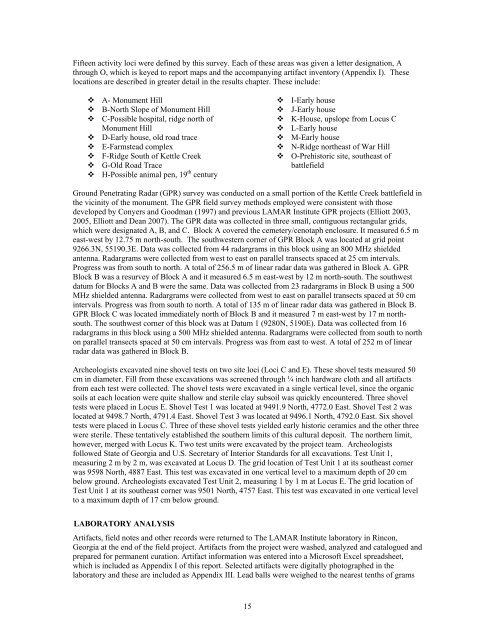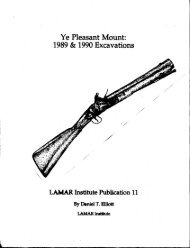Stirring Up a Hornet's Nest: - UGA Laboratory of Archaeology ...
Stirring Up a Hornet's Nest: - UGA Laboratory of Archaeology ...
Stirring Up a Hornet's Nest: - UGA Laboratory of Archaeology ...
You also want an ePaper? Increase the reach of your titles
YUMPU automatically turns print PDFs into web optimized ePapers that Google loves.
Fifteen activity loci were defined by this survey. Each <strong>of</strong> these areas was given a letter designation, A<br />
through O, which is keyed to report maps and the accompanying artifact inventory (Appendix I). These<br />
locations are described in greater detail in the results chapter. These include:<br />
� A- Monument Hill<br />
� B-North Slope <strong>of</strong> Monument Hill<br />
� C-Possible hospital, ridge north <strong>of</strong><br />
Monument Hill<br />
� D-Early house, old road trace<br />
� E-Farmstead complex<br />
� F-Ridge South <strong>of</strong> Kettle Creek<br />
� G-Old Road Trace<br />
� H-Possible animal pen, 19 th century<br />
15<br />
� I-Early house<br />
� J-Early house<br />
� K-House, upslope from Locus C<br />
� L-Early house<br />
� M-Early house<br />
� N-Ridge northeast <strong>of</strong> War Hill<br />
� O-Prehistoric site, southeast <strong>of</strong><br />
battlefield<br />
Ground Penetrating Radar (GPR) survey was conducted on a small portion <strong>of</strong> the Kettle Creek battlefield in<br />
the vicinity <strong>of</strong> the monument. The GPR field survey methods employed were consistent with those<br />
developed by Conyers and Goodman (1997) and previous LAMAR Institute GPR projects (Elliott 2003,<br />
2005, Elliott and Dean 2007). The GPR data was collected in three small, contiguous rectangular grids,<br />
which were designated A, B, and C. Block A covered the cemetery/cenotaph enclosure. It measured 6.5 m<br />
east-west by 12.75 m north-south. The southwestern corner <strong>of</strong> GPR Block A was located at grid point<br />
9266.3N, 55190.3E. Data was collected from 44 radargrams in this block using an 800 MHz shielded<br />
antenna. Radargrams were collected from west to east on parallel transects spaced at 25 cm intervals.<br />
Progress was from south to north. A total <strong>of</strong> 256.5 m <strong>of</strong> linear radar data was gathered in Block A. GPR<br />
Block B was a resurvey <strong>of</strong> Block A and it measured 6.5 m east-west by 12 m north-south. The southwest<br />
datum for Blocks A and B were the same. Data was collected from 23 radargrams in Block B using a 500<br />
MHz shielded antenna. Radargrams were collected from west to east on parallel transects spaced at 50 cm<br />
intervals. Progress was from south to north. A total <strong>of</strong> 135 m <strong>of</strong> linear radar data was gathered in Block B.<br />
GPR Block C was located immediately north <strong>of</strong> Block B and it measured 7 m east-west by 17 m northsouth.<br />
The southwest corner <strong>of</strong> this block was at Datum 1 (9280N, 5190E). Data was collected from 16<br />
radargrams in this block using a 500 MHz shielded antenna. Radargrams were collected from south to north<br />
on parallel transects spaced at 50 cm intervals. Progress was from east to west. A total <strong>of</strong> 252 m <strong>of</strong> linear<br />
radar data was gathered in Block B.<br />
Archeologists excavated nine shovel tests on two site loci (Loci C and E). These shovel tests measured 50<br />
cm in diameter. Fill from these excavations was screened through ¼ inch hardware cloth and all artifacts<br />
from each test were collected. The shovel tests were excavated in a single vertical level, since the organic<br />
soils at each location were quite shallow and sterile clay subsoil was quickly encountered. Three shovel<br />
tests were placed in Locus E. Shovel Test 1 was located at 9491.9 North, 4772.0 East. Shovel Test 2 was<br />
located at 9498.7 North, 4791.4 East. Shovel Test 3 was located at 9496.1 North, 4792.0 East. Six shovel<br />
tests were placed in Locus C. Three <strong>of</strong> these shovel tests yielded early historic ceramics and the other three<br />
were sterile. These tentatively established the southern limits <strong>of</strong> this cultural deposit. The northern limit,<br />
however, merged with Locus K. Two test units were excavated by the project team. Archeologists<br />
followed State <strong>of</strong> Georgia and U.S. Secretary <strong>of</strong> Interior Standards for all excavations. Test Unit 1,<br />
measuring 2 m by 2 m, was excavated at Locus D. The grid location <strong>of</strong> Test Unit 1 at its southeast corner<br />
was 9598 North, 4887 East. This test was excavated in one vertical level to a maximum depth <strong>of</strong> 20 cm<br />
below ground. Archeologists excavated Test Unit 2, measuring 1 by 1 m at Locus E. The grid location <strong>of</strong><br />
Test Unit 1 at its southeast corner was 9501 North, 4757 East. This test was excavated in one vertical level<br />
to a maximum depth <strong>of</strong> 17 cm below ground.<br />
BLABORATORY ANALYSIS<br />
Artifacts, field notes and other records were returned to The LAMAR Institute laboratory in Rincon,<br />
Georgia at the end <strong>of</strong> the field project. Artifacts from the project were washed, analyzed and catalogued and<br />
prepared for permanent curation. Artifact information was entered into a Micros<strong>of</strong>t Excel spreadsheet,<br />
which is included as Appendix I <strong>of</strong> this report. Selected artifacts were digitally photographed in the<br />
laboratory and these are included as Appendix III. Lead balls were weighed to the nearest tenths <strong>of</strong> grams










